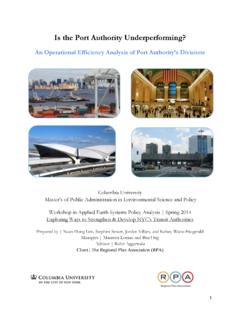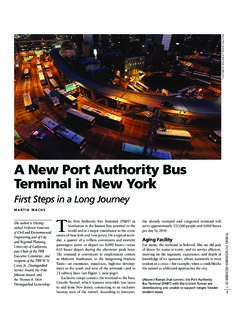Transcription of 1 Street, 26 330 West 42 - New York City
1 1 1 April 14, 2017 Chairman John Degnan The Port authority of New york and New Jersey 4 World Trade Center 150 Greenwich Street 22nd Floor New york , NY 10006 Community Guidelines On Replacing the Port authority Bus Terminal (PABT) Dear Chair Degnan: In 2016, the Port authority of New york and New Jersey revealed plans for the replacement of the Port authority Bus Terminal (PABT) on Eighth Avenue. The plans, which included the possibility of using eminent domain to take private property in Hell s Kitchen South, had been disclosed neither to the public nor to Manhattan Community Board 4 (MCB4), nor to Manhattan District 4 s (MCD4) elected representatives.
2 Manhattan Community Board 4 responded to the proposed plans with a series of public Clinton Land Use Committee and Transportation Planning Committee meetings as well as with two public community forums. Along with Manhattan Community District 4 s (MCD4) elected representatives, MCB4 held a public town hall on April 18, 2016 to hear the local Hell s Kitchen community s reaction. A second town hall to survey the community s vision of the future of Hell s Kitchen South was held on December 6, 2016. At its March 8, 2017, Clinton/Hell s Kitchen Land Use Committee meeting, the committee voted to synopsize the input from the MCB4 committees and public meetings and draft guideline on the proposal to replace the PABT.
3 These guidelines were presented to the MCB4 Full Board on April 5, 2017. The Board recommended approval of the guidelines by a vote of 33 for, 0 against, 0 present not eligible. MCB4 RESPONSE TO REPLACING THE PABT The 67-year old Port authority Bus Terminal faces, according to the Port authority , "structural limitations that complicate its day-to-day operations." Moreover, the Port authority estimates that by 2040, peak-hour passenger traffic will increase by 35% to city OF NEW york MANHATTAN COMMUNITY BOARD FOUR 330 West 42nd Street, 26th floor New york , NY 10036 tel: 212-736-4536 fax: 212-947-9512 Delores Rubin Chair Jesse Bodine District Manager 2 51% and peak-hour bus traffic by 25% to 39%.
4 In order to meet this estimated increase in bus traffic, the Board of PANYNJ contends that the current PABT must be upgraded or replaced entirely. On February 17, 2017, The Port authority of New york and New Jersey Board passed a resolution to allocate $70 million to the first phase of a comprehensive planning effort for the advancement and further definition of capital projects related to the development of a replacement for the Port authority Bus Terminal on the West Side of Manhattan (Port authority Bus terminal - Replacement Planning and Development - Planning authorization - Phase 1). The resolution included planning for support facilities, such as bus parking and staging facilities and planning for potential intermediate bus staging and storage facilities and other initiatives for the efficient operation of the interstate bus network.
5 The Port authority did not consult with MCB4 while scoping and designing this study. While Manhattan Community Board 4 recognizes the Port authority s contention that a terminal replacement can only be on the west side of Manhattan, it also recognizes that the days of obliterating a neighborhood s homes and business, churches and community institutions to replace a new bus facility are over. Any replacement for the current PABT in MCD4 must not only consider the needs of commuters, but also take into account the health, safety, and quality of life of the people in whose neighborhood a bus terminal would be located. And a terminal must integrate into the existing and future transportation infrastructure of midtown Manhattan.
6 Therefore, MCB4 insists on the following guidelines for replacing the Port authority Bus Terminal. 1. FIRST DO NO HARM 1. Avoid Eminent Domain The southern end of historic Hell s Kitchen ran from West 30th to West 42nd Streets, and from Ninth Avenue to Eleventh Avenue, comprising Hell s Kitchen South. Parts of four blocks on the northwest corner of Ninth Avenue and 40th Street; the north and south frontages of West 40th Streets between Ninth and Dyer Avenues; the east and west frontages of Ninth Avenue between West 39th and West 40th Streets; and a small mid-block portion on the southern side of West 39th Street between Ninth and Dyer Avenues ar e in shown in the Port authority s September 2015 Midtown Bus Master Plan for the site of a new or interim bus terminal and ramps.
7 Properties would have to be condemned by the Port authority for the new or interim bus terminal, resulting in the destruction of residences, businesses and community. 3 Over the past 110 years, the southern portion of Hell s Kitchen that has been impacted the most by the largest transportation infrastructure projects in the city of New york . Projects have included: The construction of Penn Station and its adjacent rail yards (1906); The construction of the Lincoln Tunnel (1938); The West Side Improvement creating a rail cut between Tenth and Eleventh Avenues (1934); The extension of the Lincoln Tunnel Dyer Avenue approaches (1957 and the mid-1970s); and, The construction of the Port authority Bus Terminal (1949-1950).
8 Each successive improvement required the loss of community institutions, the demolition of hundreds of apartments, and the displacement of hundreds of neighborhood families. The devastation and destruction of poor neighborhoods to build transportation infrastructure was not unique to New york city . It occurred in minority neighborhoods throughout the Through determined and sustained community activism since the 1970s, Hell s Kitchen has fought back against the disfigurement of the area and Hell s Kitchen has become a thriving, vibrant neighborhood and a desirable one in which to live. Homes, businesses, houses of worship, and social service organizations are essential components of the Hell's Kitchen South neighborhood.
9 Any plan to improve the current Port authority Bus Terminal should assume the preservation of homes and businesses in the affected area. They must not be demolished. 2. Comply With Existing Zoning & Prior Planning Studies This Hell s Kitchen South core area is bounded by West 41st Street on the north, West 35th Street on the south, Tenth Avenue on the west, and Ninth Avenue on the east. While the Port authority has preliminarily identified part of this area for the bus terminal expansion, MCB4 has pointed out that the area immediately west of Ninth Avenue under consideration for a new bus terminal is governed by the Special Hudson Yards District (SHYD) and that its Hell's Kitchen Subdistrict has specific restrictions against demolition.
10 MCB4, the New york city Department of city Planning, and our council member, who at that time was Speaker of the New york city Council, spent the years between 2001 and 2005 in negotiations to achieve the special district and the restrictions against demolition. Dismantling this hard-won zoning zoning carefully crafted to ensure a vibrant and balanced development of the far west side of Manhattan might seriously derail the city 's vital and ongoing efforts to encourage and integrate commercial and 1 4 residential development in the area. It should be pointed out that the city zoned the area with an expectation of producing a significant portion of affordable housing.



















